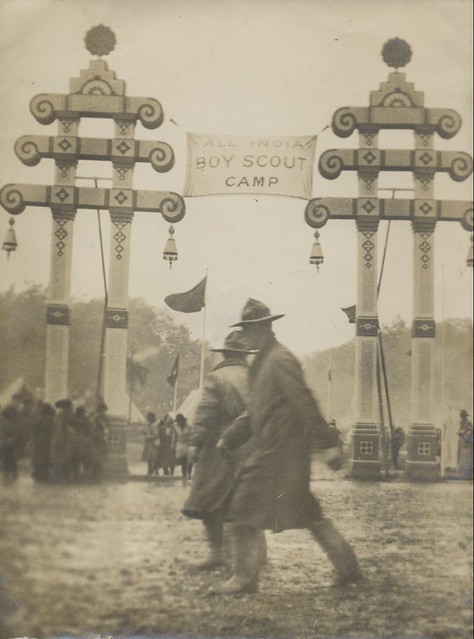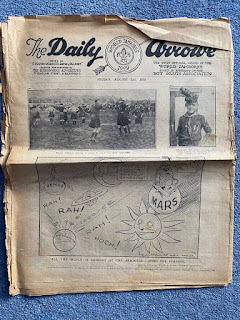බී.පී. ගේ පයට පෑගුනු මඩටත් වටිනාකමක්...
1929 දී එංගලන්තයේ බකන්හෙඩ් හි ඇරෝ උද්යානයේ පැවති 3වන ලෝක බාලදක්ෂ ජම්බෝරිය හැඳින්වූයේ "මඩ ජම්බෝරිය " නමිනි. රටවල් 35ක බාලදක්ෂයන් 30,000 ක් සහභාගි වූ මෙය මඩ ජම්බෝරිය ලෙස හැඳින්වූයේ
ආරම්භයේ සිටම ධාරානිපාත මහ වැසි හේතුවෙන් අක්කර 450ක් පමණ වූ ජම්බෝරි
භූමියට දැඩි හානි පැමිනි අතර එය මඩ ගොහුරක් විය.මේ අවස්ථාවේදී බීපී කල
ප්රකාශය බාලදක්ෂ ලොවේ කියමනක් විය.
"ඕනෑම කෙනෙකුට කඳවුවෙනුවෙන් කල හැකි වූවත් මෙවැනි මඩ වගුරක කඳවුරු බැඳිය හැක්කේ බාලදක්ෂයන්ට පමණි " මෙම ජම්බෝරිය උප කඳවුරු 8කට බෙදා තිබූ අතර එහි මද්යයේ වෙළෙඳ මධ්යස්ථානයක් ඉඳිකර තිබුනි.
"ඕනෑම කෙනෙකුට කඳවුවෙනුවෙන් කල හැකි වූවත් මෙවැනි මඩ වගුරක කඳවුරු බැඳිය හැක්කේ බාලදක්ෂයන්ට පමණි " මෙම ජම්බෝරිය උප කඳවුරු 8කට බෙදා තිබූ අතර එහි මද්යයේ වෙළෙඳ මධ්යස්ථානයක් ඉඳිකර තිබුනි.
කඳවුරට සහභාගි වූ බීපී එක් ඇමරිකානු කඳවුරක් නැරඹීමට ගිය අතර එහි වූ හොඳම කඳවුරු භූමිය තේරීම එතුමාට භාර විය. එහිදී වුල්වරීන් නම් කණ්ඩායම තෝරාගත් අතර ජේම්ස් ඊ වෙස්ට් හා ඇමරිකානු උප ජනාධිපති සමඟ කතාබහක යෙදී සිටියදී චාල්ස් මැකින්ටයර් නම් ඇමරිකානු ප්රාදේශීය කොමසාරිස් වරයෙකු බීපීගේ සපත්තුවක ඇලී තිබූ මඩ පිඬක් ගෙන ලියුම් කවරයක බාහා සීල් තැබීය. මෙම ඓතිහාසික මඩ පිඬ මොන්රෝ ප්රාන්තයේ බාලදක්ෂ කෞතුකාගාරයේ තැන්පත් කර ඇත.

බාලදක්ෂයන්ගේ කඳවුරු කොතනද වැස්ස එහි ඇත
2වන ලෝක බාලදක්ෂ ජම්බෝරිය පැවතුනේ ඩෙන්මාර්කයේ කොපන්හේගන් හිදීය. එය 1924 අගෝස්තු 9 දා සිට 17 දක්වා පැවති අතර එය කඳවුරු ආකෘතිය අනුව පැවැත්වූ පලමු ලෝක බාලදක්ෂ ජම්බෝරිය විය. එහි සමාරම්භක උළෙලේදී බේඩ්න් පවෙල් සාමිවරයා තම කතාව ආරම්භ කරත්ම ධාරානිපාත වර්ෂාව ඇදහැලෙන්නට ව්ය. අධික වර්ෂාව හේතුවෙන් ජම්බෝරියේ කොටසක් ඉවත් කල අතර එහි වූ බාලදක්ෂයන් නවාතැන් ගත්තේ අවට ගෙවල් වලය. ජම්බෝරි සමාප්ත අවස්ථාවේදී බාලදක්ෂයන් ඇමතු බේඩ්න් පවෙල් සාමිතුමා කියා සිටියේ මම කෙතරම් විශාල බාලදක්ෂ සංඛාවක් දැක ඇති මුත් මේ තරම් තෙත් බරිත වූ බාලදක්ෂයන් මීට පෙර දැක නැති බවයි.
බාලදක්ෂයන් සේම බේඩ්න් පවෙල් සාමිවරයාද තෙත් බරිතව සිට හෙයින් බාලදක්ෂයන් විසින් බීපීට "නාන මාස්ටර් " යන නම පටබඳුනු ලැබීය. එංගලන්තයේ බක්න්හේඩ් හි පැවති 3 වන ලෝක බාලදක්ෂ ජම්බෝරියේදී ද පෙර පරිදිම සිදුවිය. 1929 ජූලි 31 සිට අගෝස්තු 13 දක්වා බක්න්හේඩ් හි ඇරෝ පාර්ක් හි පැවති ජම්බෝරියේ සමාරම්භක අවස්ථාවේදී බේඩ්න් පවෙල් සාමිතුමා සිය කතාව ආරම්භ කරත්ම ධාරානිපාත වැසි ඇද හැලෙන්නට විය.අක්කර ගනනාවක කඳවුරු භූමිය දණහිස දක්වා එරෙන මඩ ගොහොරුවක් බවට පත්විය." මඩ ජම්බෝරිය" ලෙස අන්වර්ථ නාමයෙන් 3 වන ලෝක බාලදක්ෂ ජම්බෝරිය අදටත් හඳුන්වන්නේ එහෙයිනි.
ඉන් වසර 4 කට පසුව එනම් 4 වන ලෝක බාලදක්ෂ ජම්බෝරියේදී සැම දෙනාම බලාපොරොත්තු වූයේ පෙර පරිදිම බේඩ්න් පවෙල්ගේ කතාව ආරම්භ කරත්ම වැසි ඇදහැලෙනු ඇතැයි යනුවෙනි .එහෙත් එහි වු කාලගුණික තත්වය මත කාලගුණ අනාවැකි කරුවන් කියා සිටියේ වැසි ඇතිවීමේ අවදානමක් නොමැති බවයි. 1933 අගෝස්තු 2 දා සවස 4 වන ලෝක ජම්බෝරියේ ආරම්භක කතාව පිණිස බේඩ්න් පවෙල් නැඟිට්ටා පමණි අහස් කුස කළු වළාවන්ගෙන් පිරී යන්නට විය.අනාවැකි කරුවන් බියෙන් වෙවුලා ගියේය. සොබා දහමේ හාස්කමක් මෙන් බීපීගේ කතාව අතර තුර එකඳු වැසි බිඳුවක් හෝ වැටුනේ නැත.හෙතෙමගේ කතාව අවසන් වත්ම කළුවන් අහස හිරු එලියෙන් දීප්තිමත්ව බැබළෙන්නට විය.
විශේෂ ස්තූතිය
Dharmalal Gunawardena
--------------------------------------------------------------------
3rd World Scout Jamboree
The 3rd World Scout Jamboree was held in 1929 at Arrowe Park in Upton, Merseyside, United Kingdom. As it was commemorating the 21st birthday of Scouting for Boys and the Scouting movement, it is also known as the Coming of Age Jamboree. With about 30,000 Scouts and over 300,000 visitors attending, this jamboree was the largest jamboree so far. From 29 July to 12 August 1929, the third World Scout Jamboree was held at Arrowe Park, in Birkenhead, United Kingdom. This jamboree commemorated the 21st birthday of Scouting, counting from the publication of the book Scouting for Boys by General Baden-Powell. Therefore, this jamboree is also known as the Coming of Age Jamboree.

The Jamboree on a site of 450 acres (1.8 km2) was opened by the Duke of Connaught, the president of the Boy Scout Association, and thirty thousand Scouts and Girl Guides
of many countries attended. During the first week, the weather was
poor, turning the park grass into ankle deep mud, gaining the jamboree
its nickname jamboree of mud. The camp was organized in eight subcamps, around a specially built town
in the middle, called Midway, where Scouts could purchase materials.
Each subcamp provided pitches for a contingent of Scouts troops. The
organization of daily chores such as cooking, campfire collecting, etc.
were done in turn by the groups.
The Girl Guides in Cheshire were asked to run a hospital under canvas.
There were 321 cases admitted and 2323 out-patient cases during the
Jamboree. Only 52 cases had to be sent to other hospitals. Staff dealt
with a range of problems from minor cuts, burns and sprains to fractures
and head injuries. Two Guiders ran a dispensary providing both prescription
and non-prescription medicines. There was also a dental clinic and an
operating theatre. The hospital canteen provided meals for patients and
the 50 members of staff, including many special diets, all cooked on
open fires. Staff were asked to accommodate lost boys after the Wolf Cub rally. The hospital was also proud to be asked to provide the bedding and equipment for the Prince of Wales'
tent. This hospital had the far-reaching effect that many heads of Boy
Scout movements from other countries saw the excellent work of the Girl
Guides and changed their attitudes towards them.
This photograph shows the South African contingent at the Boy Scouts’
third World Jamboree, held in England in 1929. The jamboree was known as
the “Coming of Age” Jamboree, since it marked twenty-one years since
the foundation of the Boy Scouts. The photograph provide insights into
the core ideals of the Boy Scouts and, more broadly, representations of
masculinity and boys’ roles as future empire builders. It reflects the
heavy emphasis on militarism, rugged masculinity, and having boys
experience “frontier” or outdoors life.
On Baden-Powell a peerage was to be conferred by King George V, as was announced on 2 August by the Prince of Wales who attended the Jamboree in Scout uniform. The formal title of Baron Baden-Powell, of Gilwell, co. Essex was granted on 17 September 1929, confirming the high notion Baden-Powell had of education and training, after Gilwell Park where the international Scout Leader training in the Wood Badge course took place.
In the morning of Sunday 4 August, an open air thanksgiving service was held, presided by Cosmo Lang, Archbishop of Canterbury, and by Francis Bourne, Archbishop of Westminster, for Protestant and Catholic Scouts; and later that day a service was also held in Liverpool Cathedral.
On 10 August, the Chief Scout Sir Robert Baden-Powell was given special attention. On behalf of all Scouts worldwide, he was presented with a Rolls-Royce motor car and a caravan trailer. The caravan was nicknamed Eccles and is now on display at Gilwell Park. These gifts were paid for by penny donations of more than 1 million Scouts worldwide. The car, nicknamed Jam Roll, was sold after his death by Olave Baden-Powell in 1945. Jam Roll and Eccles were reunited at Gilwell for the 21st World Scout Jamboree
in 2007. Recently it has been purchased on behalf of Scouting and is
owned by a charity, B–P Jam Roll Ltd. Funds are being raised to repay
the loan that was used to purchase the car. Also he was given an oil painted portrait by David Jagger, which since has been used as a publicity picture by many Scout organizations. It is on display in the Baden-Powell House. Lastly, Baden-Powell was given a cheque for £2,750 and an illuminated address.






No comments:
Post a Comment